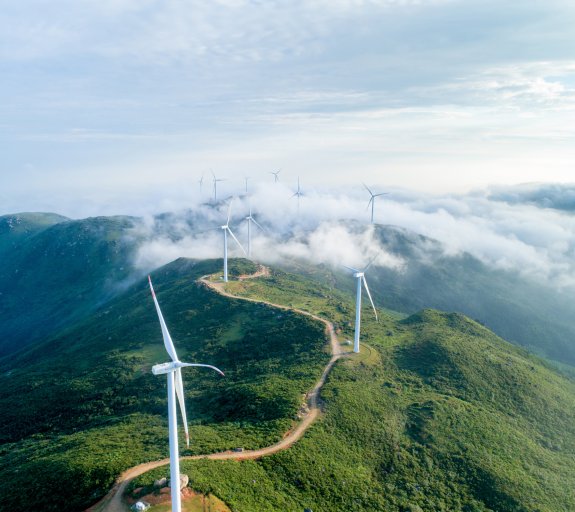
Why green energy is nowhere near bubble territory
- 13 April 2021 (5 min read)
Last year an extraordinary shift took place among both corporates and investors in their collective attitude to green energy.
Surpassing the pace of any trends seen before in the environmental, social and governance (ESG) investment universe, the move to sustainability manifested itself across many areas of the economy, particularly in clean energy.
Net zero emissions targets from some of the world’s biggest companies, including the likes of Alphabet and Facebook, supplemented similar pledges from governments, as the desire to “build back better” globally came to the fore during the pandemic.
These were more than just words. Alphabet, for example, said it planned to be carbon free by 2030 (having pledged to be carbon neutral back in 2007). Wind, solar and other renewable sources accounted for 61% of the Google parent’s global hourly electricity usage in 2019, and the company intends to go further as we move through the decade.
Facebook said it would become 100% supported by renewable energy in 2020, while committing to net-zero emissions for its entire “value chain” by 2030, including its suppliers and users.
Bubble territory?
The impact on green energy stocks from these pledges by the technology giants and other corporates across the global economy, combined with similar overtures from governments, is one important growth driver for green energy companies.
In anticipation of the huge investment in clean, smart efficient energy these actions need to make them a reality, many green energy names saw share prices double or more in 2020.
One index of clean energy companies, called the Nasdaq Clean Edge Green Energy Index fund, rose some 204%1 last year.
There’s no doubt returns like this look extraordinary at first glance, and naturally lead to questions about valuations. For us, this issue can only be mitigated by proper fundamental analysis of each company in the space, its opportunity and competitive position, and a considered view of the valuation.
But as part of this analysis, it is important to recognise that we have hit an inflection point for energy transition globally. Last year, amid the pandemic, capex spent on energy transition was one of the only areas to see higher commitments.
One study2 from IHS Markit published in January said capital expenditure on global renewable energy is set to increase 14% in the five years ending in 2025, compared with spending in the 2015-2019 period.
The report added combined global, wind and solar energy installed capacity would surpass global installed natural gas-fired capacity in 2023, and coal-fired capacity in 2024.
This is a crucial point behind the performance of green energy last year, and why we think the fundamentals remain very strong. Companies simply must move to renewable energy over time, and that means the addressable market for businesses providing that energy has materially increased.
This in turns means growth rates should be higher, and higher for longer, while the public statements from an ever-growing number of corporates which need renewable energy has created a lot of visibility about future earnings for the businesses able to provide it.
Analysts in this expanding sector are still increasing their estimates, so the consensus on these stocks and their future prospects have still not, in our view, moved up to properly reflect their potential.
The front runners in global energy transition
There are many companies operating in the energy transition space, from renewable energy, energy efficiency and management, and smart grid and storage solutions which support renewables on and off the grid.
NextEra Energy is one such company. The US-listed utility is already the largest generator of wind and solar power globally and is committed to a strategy of continued leadership in clean energy infrastructure.
Ameresco, another US-listed name, plays a different – but just as crucial – role in the sector. An energy service company, it works with government, healthcare, public, and education sectors to help different establishments improve energy usage and efficiency.
Europe has its share of names involved in the sector, including Schneider Electric, the multinational business providing energy and automation solutions digitally to improve energy efficiency.
These are proven technologies already operating at commercial scale, with the ability to transform how we create and use energy for years to come.
Expertise is needed to approach the sector and find tomorrow’s winners. But what is not in doubt is the dynamics behind this market.
Energy transition is happening, and it has powerful tailwinds behind it. The universe of opportunities is already rich and diverse, and the pace of innovation continues to throw up new and exciting areas for potential investment.
All stock/company examples are for explanatory/illustrative purposes only. They should not be viewed as investment advice or a recommendation from AXA IM.
- Rmlyc3QgVHJ1c3QgTkFTREFRwq4gQ2xlYW4gRWRnZcKuIEdyZWVuIEVuZXJneSBJbmRleCBGdW5kIChRQ0xOKSAoZnRwb3J0Zm9saW9zLmNvbSk=
- UmVuZXdhYmxlcyBjYXBleCB0byBjbGltYiAxNCUgdGhyb3VnaCAyMDI1OiBJSFMgTWFya2l0IHwgSUhTIE1hcmtpdA==

What is Clean Tech?
Unsustainable human civilisation on earth is now a reality. Awareness of this is steadily rising among governments, companies and consumers alike, creating opportunities for investors
Explore Clean TechVisit the fund centre
Our CleanTech strategy aims to capture the long-term growth potential of the clean economy through four sub-themes
View fundsNot for Retail distribution
This document is intended exclusively for Professional, Institutional, Qualified or Wholesale Clients / Investors only, as defined by applicable local laws and regulation. Circulation must be restricted accordingly.
This promotional communication does not constitute investment research or financial analysis relating to transactions in financial instruments as per MIF Directive (2014/65/EU), nor does it constitute on the part of AXA Investment Managers or its affiliated companies an offer to buy or sell any investments, products or services, and should not be considered as solicitation or investment, legal or tax advice, a recommendation for an investment strategy or a personalized recommendation to buy or sell securities.
Due to its simplification, this document is partial and opinions, estimates and forecasts herein are subjective and subject to change without notice. There is no guarantee that forecasts made will come to pass. Data, figures, declarations, analysis, predictions and other information in this document is provided based on our state of knowledge at the time of creation of this document. Whilst every care is taken, no representation or warranty (including liability towards third parties), express or implied, is made as to the accuracy, reliability or completeness of the information contained herein. Reliance upon information in this material is at the sole discretion of the recipient. This material does not contain sufficient information to support an investment decision.
Before making an investment, investors should read the relevant Prospectus and the Key Investor Information Document / scheme documents, which provide full product details including investment charges and risks. The information contained herein is not a substitute for those documents or for professional external advice.
The products or strategies discussed in this document may not be registered nor available in your jurisdiction. Please check the countries of registration with the asset manager, or on the web site https://www.axa-im.com/en/registration-map, where a fund registration map is available. In particular units of the funds may not be offered, sold or delivered to U.S. Persons within the meaning of Regulation S of the U.S. Securities Act of 1933. The tax treatment relating to the holding, acquisition or disposal of shares or units in the fund depends on each investor’s tax status or treatment and may be subject to change. Any potential investor is strongly encouraged to seek advice from its own tax advisors.
Past performance is not a guide to current or future performance, and any performance or return data displayed does not take into account commissions and costs incurred when issuing or redeeming units. The value of investments, and the income from them, can fall as well as rise and investors may not get back the amount originally invested. Exchange-rate fluctuations may also affect the value of their investment. Due to this and the initial charge that is usually made, an investment is not usually suitable as a short term holding.
Risk Warning
The value of investments, and the income from them, can fall as well as rise and investors may not get back the amount originally invested.